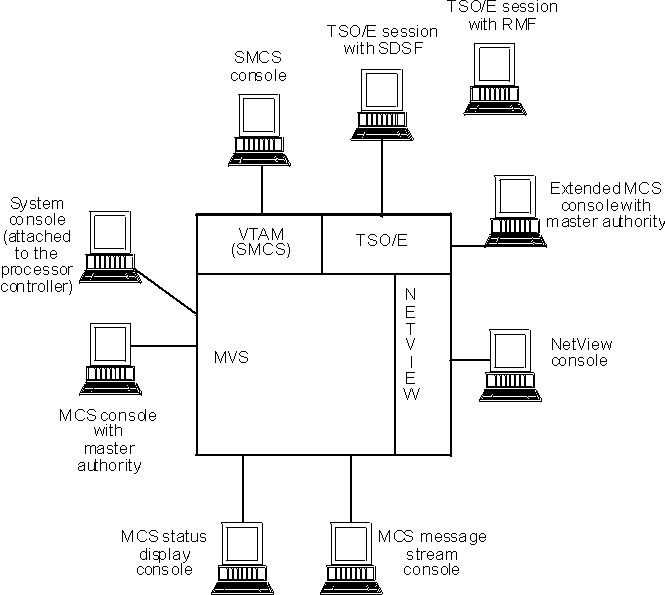 z/OS MVS Planning: Operations
z/OS MVS Planning: Operations
 z/OS MVS Planning: Operations
z/OS MVS Planning: Operations
|
Previous topic |
Next topic |
Contents |
Contact z/OS |
Library |
PDF
Multiple console support and the MVS environment z/OS MVS Planning: Operations SA23-1390-00 |
|
|
Generally, operators on an MVS™ system receive messages and enter commands on MCS and SMCS consoles. (Operators can use other consoles such as NetView® consoles, to interact with MVS, but this information primarily describes MCS and SMCS consoles and how to plan for their use. Installations can enhance their MVS operations by using extended MCS consoles. See Extended MCS consoles.) MCS consoles are devices that are locally attached to an MVS system and provide the basic communication between operators and MVS. (MCS consoles are attached to control devices that do not support systems network architecture (SNA) protocols.) SMCS consoles are devices that do not have to be locally attached to an MVS system and provide the basic communication between operators and MVS. SMCS consoles use z/OS® Communications Server to provide communication between operators and MVS instead of direct I/O to the console device. In general, there are small differences in the techniques you use to define and activate MCS consoles and SMCS consoles. Once the consoles are activated, however, MCS consoles and SMCS consoles are very much alike. You can define MCS and SMCS consoles in a console configuration according to different functions. Important messages that require action can be directed to an operator who can act by entering commands on the console. Another console can act as a monitor to display messages to an operator working in a functional area like a tape pool library or to display messages about printers at your installation. Defining a console configuration is an important part of your MVS operations planning. You define a console configuration by defining the devices you want to use as consoles and their console attributes, in the CONSOLxx parmlib member. In CONSOLxx, these console attributes control important console functions like the types of commands operators can enter from the console, routing information for messages and commands, and how to use the console. CONSOLxx and the MCS and SMCS console attributes that you can control are described in Summary of CONSOLxx and commands to change values. Figure 1 shows a console configuration for an MVS system that also includes the system console, an SMCS console, NetView, and TSO/E. Figure 1. Console Configuration for an MVS System
 The system console function is provided as part of the Hardware Management Console (HMC). An operator can use the system console to initialize MVS and other system software and during recovery situations when other consoles are unavailable. In addition to MCS and SMCS consoles, the MVS system shown in Figure 1 has a NetView console defined to it. NetView works with system messages and command lists to help you automate MVS operator tasks. You can control many system operations from a NetView console. For information about MVS operations and NetView, see Automated operations and z/OS operations planning. Users can monitor many MVS system functions from TSO/E terminals. Using the System Display and Search Facility (SDSF) and the Resource Measurement Facility™ (RMF™), TSO/E users can monitor MVS and respond to workload balancing and performance problems. For information about MVS operations and SDSF, see SDSF and MVS operations planning. For information about MVS operations and RMF, see RMF and MVS operations planning. An authorized TSO/E user can also initiate an extended MCS console session to interact with MVS. For information on extended MCS consoles, see Extended MCS consoles. The MCS consoles in Figure 1 include the
following:



|
 Copyright IBM Corporation 1990, 2014 Copyright IBM Corporation 1990, 2014 |